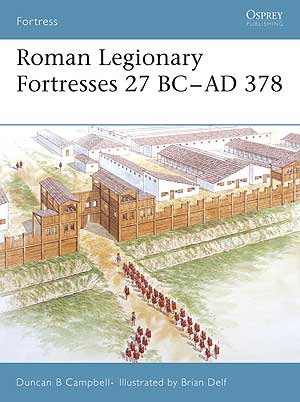
The jolly colorful cover conceals a wealth of information, fascinating to anyone who has ever wondered, "What did they do in Roman legionary fortresses, anyway?" or "How many legions did Antoninus Pius actually have?"
It has already received favorable commentary from those hard-hitting critics at Roman Army Talk. So, what's stopping you? Get straight out to a well-stocked Ancient History/ Humanities/ Archaeology newsstand near you, and start browsing.
You know it makes sense.
The question is though, does this author know his stuff? "Campbell" doesn't sound very Roman. Are you sure he can be trusted? :-)
ReplyDeleteOnly £7.59 on Amazon! Cheap at half the price.
Campbell... TRUSTED?? ... Piffle.
ReplyDeleteReviewed on Amazon:
ReplyDelete"If you are thinking of buying a great introduction to the Roman fort then this book is your best bet. Duncan Campbell looks the evolution of the Roman fort, from the earliest marching camps of the Legions, to the small but formidable forts of the late empire.
The author also looks at the typical buildings, walls and other features of the Roman fort. These include sections on the defences, the headquarters, granaries, hospitals, workshops and baths. He makes good use of archaeological reconstructions in these sections, showing us how the fort operated.
But what about living in the fort? He also gives us a snapshot view of life in the Roman fort, with looks at the Commander's house, the tribunes' houses and the barrack blocks.
I was glad to see that the Late Roman fort was given a look, as these are usually ignored in other books. Although it was not as detailed as I would have liked, I still enjoyed this short section.
Brian Delf provides some good colour plates, showing us reconstructive paintings of walls, barrack rooms and cutaways of the fort's baths. Photographs and maps are also included.
This book is by no means an in-depth look at the subject, but it is a brilliant introduction. Highly recommended!"
R MacDonald wrote:
ReplyDelete"Campbell....TRUSTED??....piffle."
The more so when it is realised that Duncan Campbell is blowing his own trumpet, and denigrating his 'rival' authors shamelessly.
Reviewed on Amazon (5 stars):
ReplyDeleteGreat work from Duncan Campbell that provides an huge amount of data in only 64 pages.
It focuses mainly on fortifications from the 1st and 2nd centuries, but also gives some information about the location and layout of 4th century fortresses like the one in Bethorus.
The author locates the strategic deployment of Roman Legions and their fortresses from the time of Augustus till the Severan period with some detail. The similarities between the marching camps and the permanent fortresses layout, the question of the double strenght first cohort (arqueology can't answer that question yet) and the several buildings that constitute those fortresses, including the principia (HQ), fabricae (factories/workshops), valetudinarium (Hospital), horrea (granaries), thermae (baths)and the living quarters of officers and legionaries are also described.
Roman fortresses weren't castles; the objective of their existence was quartering one or two legions on a permanent or semi-permanent base. They were huge barracks, almost cities (some cities actually evolved from roman fortresses!). So the physical defences of those fortresses weren't very impressive, but they didn't needed to be; for the romans of the first and second centuries the strongest defence was their legionaries. Most adversaries would be faced outside the fortress not behind walls.
Good maps and photographs, excellent paintings by Brian Delf. Recommended.
Grateful for shariing this
ReplyDelete